- Europa und der Stier
- Leda und die Schildkröte
- Sterope und Herkules
- Herodikos und die Turnerinnen
- Phoroneus und die Hirtin
- Minos und Persipeia
- Phryne und Mutter
- Pytalos und Demeter
- Kirke und die Ferkel
- Putiphar
-
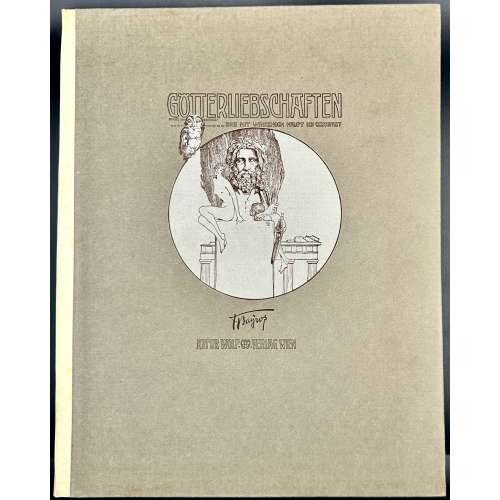 Letterpress title-page, engraved title-page, and 10 sheets of collotype plates printed on india paper mounted on thick wove paper, with captioned guard sheets, loose in a vellum-backed cardboard portfolio with cloth-mounted flaps; floral diaper design inside throughout; bookseller's label to front board verso; limited edition of 550 copies of which this is copy № 103. Dimensions: 338 x 268 mm portfolio; 325 x 260 mm sheet, 225 x 195 mm image. Front board with lettering and vignette: GÖTTERLIEBSCHAFTEN | DAS MIT WINKENDEM HAUPT ICH GEWAHRET | {vignette} | {signature} | ARTUR WOLF / VERLAG WIEN || Letterpress title-page: FRANZ VON BAYROS | “GÖTTERLIEBSCHAFTEN” | ARTUR WOLF / VERLAG WIEN | 1914 || Verso to letterpress t.p. VERZEICHNIS DER TAFELN.
Letterpress title-page, engraved title-page, and 10 sheets of collotype plates printed on india paper mounted on thick wove paper, with captioned guard sheets, loose in a vellum-backed cardboard portfolio with cloth-mounted flaps; floral diaper design inside throughout; bookseller's label to front board verso; limited edition of 550 copies of which this is copy № 103. Dimensions: 338 x 268 mm portfolio; 325 x 260 mm sheet, 225 x 195 mm image. Front board with lettering and vignette: GÖTTERLIEBSCHAFTEN | DAS MIT WINKENDEM HAUPT ICH GEWAHRET | {vignette} | {signature} | ARTUR WOLF / VERLAG WIEN || Letterpress title-page: FRANZ VON BAYROS | “GÖTTERLIEBSCHAFTEN” | ARTUR WOLF / VERLAG WIEN | 1914 || Verso to letterpress t.p. VERZEICHNIS DER TAFELN. -
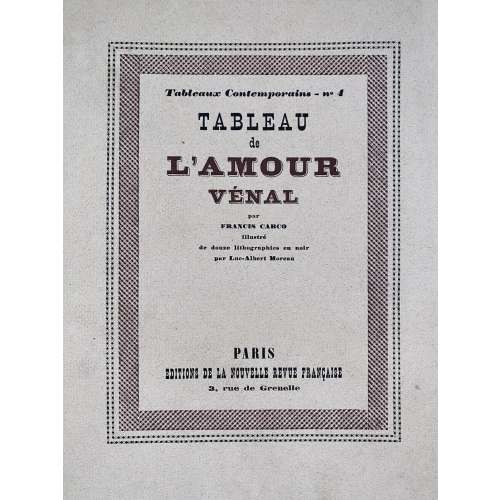 Description: Softcover, French flapped wrappers, lettered front, back (advert.) and spine, collated in-4to, 24.3 x 20.2 cm, printed on thick wove paper Vélin pur fil Lafuma-Navarre, print run limited to 335 copies from which this is copy № 219; outer margin untrimmed, some leaves uncut, glassine DJ. Limitation: 1 copy (A) on Japon Impérial + double suite of plates + suite of original drawings, 4 copies (B-E) on Japon Impérial + double suite of plates, 15 copies on on Japon Impérial + suite of plates on Vieux Japon teinté (F-T), 315 copies on Vélin pur fil Lafuma-Navarre, of which 15 (I-XV) not for sale. Copyright: Libraire Gallimard, 1924. Printed: March 10, 1924 – text by Coulouma (Argenteuil) under direction of H. Barthélemy, lithographs printed by Marchizet (Paris). Front wrapper (in letterpress two-colour border): Tableaux Contemporains – no 4 | . TABLEAU | de | L'AMOUR | VÉNAL | par | FRANCIS CARCO | Illustré | de douze lithographies en noir | par Luc-Albert Moreau | PARIS | ÉDITIONS DE LA NOUVELLE REVUE FRANÇAISE | 3, rue de Grenelle || Title-page: Same, without a frame, in black, L'AMOUR | VÉNAL in brown. Collation: 4to; 14 a4 2-164, total 68 leaves with wrappers included in collation plus 12 plates, incl. frontispiece, extraneous to collation. Pagination: [2 wrapper] [6] [i] ii-vii [viii blank] [9] 10-122 [2 colophon] [2 blank] [2 wrapper]; total 136 pages incl. wrappers, plus ils. Contributors: Francis Carco [François Carcopino-Tusoli] (French, 1886 – 1958) – author. Luc-Albert Moreau (French, 1882 – 1948) – artist. La Nouvelle Revue Française (nrf) (Paris)– publisher. Gaston Gallimard (French, 1881 – 1975) – publisher.
Description: Softcover, French flapped wrappers, lettered front, back (advert.) and spine, collated in-4to, 24.3 x 20.2 cm, printed on thick wove paper Vélin pur fil Lafuma-Navarre, print run limited to 335 copies from which this is copy № 219; outer margin untrimmed, some leaves uncut, glassine DJ. Limitation: 1 copy (A) on Japon Impérial + double suite of plates + suite of original drawings, 4 copies (B-E) on Japon Impérial + double suite of plates, 15 copies on on Japon Impérial + suite of plates on Vieux Japon teinté (F-T), 315 copies on Vélin pur fil Lafuma-Navarre, of which 15 (I-XV) not for sale. Copyright: Libraire Gallimard, 1924. Printed: March 10, 1924 – text by Coulouma (Argenteuil) under direction of H. Barthélemy, lithographs printed by Marchizet (Paris). Front wrapper (in letterpress two-colour border): Tableaux Contemporains – no 4 | . TABLEAU | de | L'AMOUR | VÉNAL | par | FRANCIS CARCO | Illustré | de douze lithographies en noir | par Luc-Albert Moreau | PARIS | ÉDITIONS DE LA NOUVELLE REVUE FRANÇAISE | 3, rue de Grenelle || Title-page: Same, without a frame, in black, L'AMOUR | VÉNAL in brown. Collation: 4to; 14 a4 2-164, total 68 leaves with wrappers included in collation plus 12 plates, incl. frontispiece, extraneous to collation. Pagination: [2 wrapper] [6] [i] ii-vii [viii blank] [9] 10-122 [2 colophon] [2 blank] [2 wrapper]; total 136 pages incl. wrappers, plus ils. Contributors: Francis Carco [François Carcopino-Tusoli] (French, 1886 – 1958) – author. Luc-Albert Moreau (French, 1882 – 1948) – artist. La Nouvelle Revue Française (nrf) (Paris)– publisher. Gaston Gallimard (French, 1881 – 1975) – publisher. -
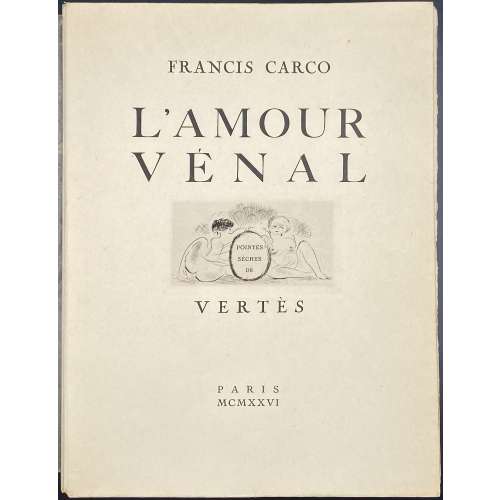 Description: One volume, publisher’s original tan French flapped wrappers with engraved vignette, in glassine DJ, unbound, 25.5 x 19.5 cm, collated in-4to, bottom and outer margins untrimmed, some pages uncut, printed on laid watermarked Van Gelder Zonen paper, illustrated with 15 full-page drypoint plates, some with tissue guard; front wrapper, t.p. and table vignettes, numerous head- and tailpieces by R. Lacourière after drawings by Marcel Vertès, enriched with two cancelled images printed on different laid papers in different states, three of each image. Printed on June 10, 1926 by Coulouma (Argenteuil) under the direction of H. Barthélemy, drypoints by Roger Lacourière (Paris). Limitation: 95 copies of which № 1 on Japon Ancien, № № 2-26 on Japon Impérial, and №№ 27-95 on Hollande. This is copy № 78. Front wrapper: FRANCIS CARCO | L'AMOUR | VÉNAL | {vignette with inscription in oval tablet «POINTES | SÈCHES | DE» } | VERTÈS | PARIS | MCMXXVI || Title-page: FRANCIS CARCO | L'AMOUR | VÉNAL | {vignette} | POINTES SÈCHES DE | VERTÈS | PARIS | MCMXXVI || Collation: 2 leaves in wrapper, π4 (fac-simile of Carco a.l.s., h.t., t.p., authorship) a4 (preface), 1-164 [17]4, 2 leaves in wrapper; total without the wrapper 76 leaves plus 15 plates, plus 6 plates of enrichment plates. Pagination: [8] [i] [ii-viii] [1] 2-128 [8], total 152 pages, ils. Note: The edition is not in Dutel, not in Pia (Enfer); Fekete (2014): № 215, p. 117; Vokaer (1967): № 15, p.10. According to both sources, it is a 2-volume edition, with text in vol. 1 and plates in vol. 2. Vokaer attributes publishing to La Roseraie (Paris) and provides for 45 drypoints of which 18 full-page plates in the second volume. Fekete (Christie’s) provides for 15 full-page plates and 25 illustrations in text. Contributors: Francis Carco [François Carcopino-Tusoli] (French, 1886 – 1958) – author. Marcel Vertès [Marcell Vértes] (Jewish-Hungarian-French, 1895 – 1961) – artist. Roger Lacourière (French, 1892 – 1966) – engraver, printer.
Description: One volume, publisher’s original tan French flapped wrappers with engraved vignette, in glassine DJ, unbound, 25.5 x 19.5 cm, collated in-4to, bottom and outer margins untrimmed, some pages uncut, printed on laid watermarked Van Gelder Zonen paper, illustrated with 15 full-page drypoint plates, some with tissue guard; front wrapper, t.p. and table vignettes, numerous head- and tailpieces by R. Lacourière after drawings by Marcel Vertès, enriched with two cancelled images printed on different laid papers in different states, three of each image. Printed on June 10, 1926 by Coulouma (Argenteuil) under the direction of H. Barthélemy, drypoints by Roger Lacourière (Paris). Limitation: 95 copies of which № 1 on Japon Ancien, № № 2-26 on Japon Impérial, and №№ 27-95 on Hollande. This is copy № 78. Front wrapper: FRANCIS CARCO | L'AMOUR | VÉNAL | {vignette with inscription in oval tablet «POINTES | SÈCHES | DE» } | VERTÈS | PARIS | MCMXXVI || Title-page: FRANCIS CARCO | L'AMOUR | VÉNAL | {vignette} | POINTES SÈCHES DE | VERTÈS | PARIS | MCMXXVI || Collation: 2 leaves in wrapper, π4 (fac-simile of Carco a.l.s., h.t., t.p., authorship) a4 (preface), 1-164 [17]4, 2 leaves in wrapper; total without the wrapper 76 leaves plus 15 plates, plus 6 plates of enrichment plates. Pagination: [8] [i] [ii-viii] [1] 2-128 [8], total 152 pages, ils. Note: The edition is not in Dutel, not in Pia (Enfer); Fekete (2014): № 215, p. 117; Vokaer (1967): № 15, p.10. According to both sources, it is a 2-volume edition, with text in vol. 1 and plates in vol. 2. Vokaer attributes publishing to La Roseraie (Paris) and provides for 45 drypoints of which 18 full-page plates in the second volume. Fekete (Christie’s) provides for 15 full-page plates and 25 illustrations in text. Contributors: Francis Carco [François Carcopino-Tusoli] (French, 1886 – 1958) – author. Marcel Vertès [Marcell Vértes] (Jewish-Hungarian-French, 1895 – 1961) – artist. Roger Lacourière (French, 1892 – 1966) – engraver, printer. -
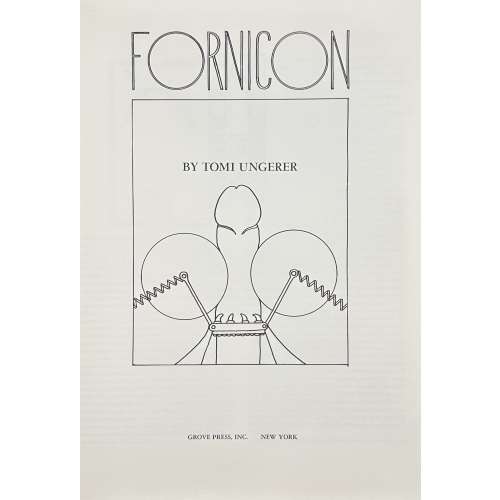 Hardcover, 333 x 247 mm, black cloth with gilt facsimile to front board and gilt lettering to spine, aubergine dust jacket with white lettering and red facsimile over black panel to front and back, crimson endpapers, laid paper, unpaginated; pp.: [4] h.t./blank, t.p./imprint, [2] text by John Hollander, 61 leaves of plates; originally published in 1969 by Rhinoceros Press, New York, as a limited-edition portfolio with slipcase. Title-page: Fornicon | (in frame) BY TOMI UNGERER | GROVE PRESS NEW YORK || Jean-Thomas [Tomi] Ungerer (French,1931 – 2019) John Hollander (American, 1929 – 2013)
Hardcover, 333 x 247 mm, black cloth with gilt facsimile to front board and gilt lettering to spine, aubergine dust jacket with white lettering and red facsimile over black panel to front and back, crimson endpapers, laid paper, unpaginated; pp.: [4] h.t./blank, t.p./imprint, [2] text by John Hollander, 61 leaves of plates; originally published in 1969 by Rhinoceros Press, New York, as a limited-edition portfolio with slipcase. Title-page: Fornicon | (in frame) BY TOMI UNGERER | GROVE PRESS NEW YORK || Jean-Thomas [Tomi] Ungerer (French,1931 – 2019) John Hollander (American, 1929 – 2013) -
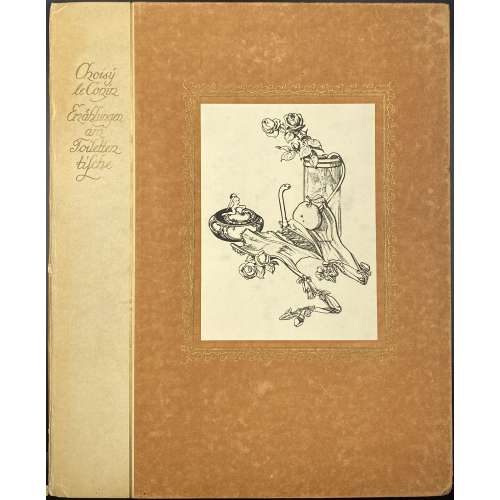 Publisher's flapped portfolio 32.8 x 26.8 cm, gilt-ruled and gilt-lettered quarter faux-parchment waxed paper over brown paper boards with pasted illustration after von Bayros within gilt arabesque frame. Possibly published in Vienna by Heinrich Conrad in 1905 or 1908. The portfolio contains the title page with a vignette and 15 loose wove paper sheets 32 x 26.2 cm of collotype reproductions after drawings by Franz von Bayros. Cover gilt lettering: Choisÿ | le Conin | Erzählungen | am | Toiletten- | tische || Title-page: Erzählungen | am Toilettentische | von | CHOISY LE CONIN | {vignette} || Title-page verso: Inhalt: | 1. Die Tabaksdose | 2. Viola de Gamba | 3. Der Bote | 4. Nicht drängeln, Kinder! | 5. Die blaue Feder | 6. O what a pretty like-place! | 7. Die Sonnenuhr |8. Der Temel der der Cotÿs | 9. Der Fetischist | 10. Jupiter und Europa | 11. Die Witwe | 12. Paroxÿsme-erotique | 13. Der Rivale | 14. Die rote Lehrerin | 15. Tantalus | Nicht im Handel. || Catalogue raisonné: The amorous drawings of the Marquis von Bayros / Part I and II. — NY: Cythera Press, 1968; pp. 95-111 [LIB-2246.2019]
Publisher's flapped portfolio 32.8 x 26.8 cm, gilt-ruled and gilt-lettered quarter faux-parchment waxed paper over brown paper boards with pasted illustration after von Bayros within gilt arabesque frame. Possibly published in Vienna by Heinrich Conrad in 1905 or 1908. The portfolio contains the title page with a vignette and 15 loose wove paper sheets 32 x 26.2 cm of collotype reproductions after drawings by Franz von Bayros. Cover gilt lettering: Choisÿ | le Conin | Erzählungen | am | Toiletten- | tische || Title-page: Erzählungen | am Toilettentische | von | CHOISY LE CONIN | {vignette} || Title-page verso: Inhalt: | 1. Die Tabaksdose | 2. Viola de Gamba | 3. Der Bote | 4. Nicht drängeln, Kinder! | 5. Die blaue Feder | 6. O what a pretty like-place! | 7. Die Sonnenuhr |8. Der Temel der der Cotÿs | 9. Der Fetischist | 10. Jupiter und Europa | 11. Die Witwe | 12. Paroxÿsme-erotique | 13. Der Rivale | 14. Die rote Lehrerin | 15. Tantalus | Nicht im Handel. || Catalogue raisonné: The amorous drawings of the Marquis von Bayros / Part I and II. — NY: Cythera Press, 1968; pp. 95-111 [LIB-2246.2019] -
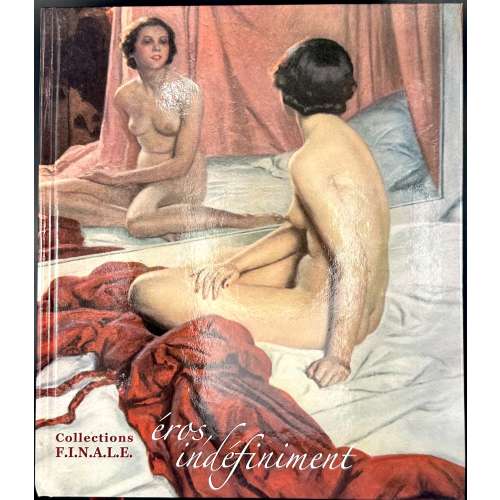 NEWHardcover volume, 297 x 256 x 40 mm, glossy pictorial boards, pp. [1-8] 9-428 [4], profusely illustrated, text in French. F.I.N.A.L.E. stands for Foundation Internationale d’Arts et Litératures Érotiques (Foundation of Erotic Arts and Literatures, established on December 12, 1996 in Lausanne, Switzerland. Title-page: éros, | indéfiniment | Collections F.I.N.A.L.E. | { HumuS, publisher’s device} ||
NEWHardcover volume, 297 x 256 x 40 mm, glossy pictorial boards, pp. [1-8] 9-428 [4], profusely illustrated, text in French. F.I.N.A.L.E. stands for Foundation Internationale d’Arts et Litératures Érotiques (Foundation of Erotic Arts and Literatures, established on December 12, 1996 in Lausanne, Switzerland. Title-page: éros, | indéfiniment | Collections F.I.N.A.L.E. | { HumuS, publisher’s device} || -
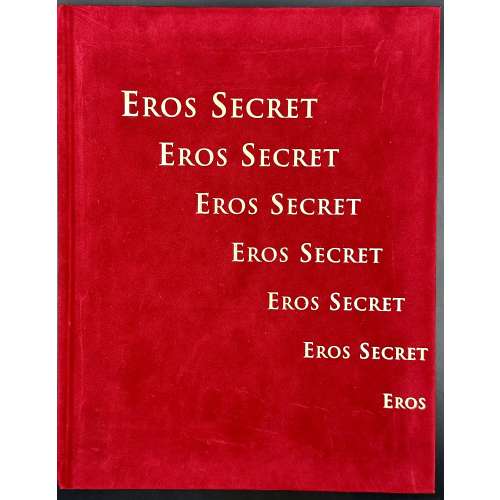 NEWHardcover volume, 290 x 225 mm, bound in scarlet velveteen with gilt lettering to front and spine, gilt vignette and lettering to back; pp.: [1-8] 9-204 [4], profusely illustrated; text in French and English. ISBN : 2-940127-37-9. Title-page (yellow on red paper): EROS SECRET | OBJETS EROTIQUES A TRANSFORMATION | EROTIC TRANSFORMATION OBJECTS | Photographies et chorégraphie : Véronique Willemin | Photographer and choreography || “The ensemble of 150 objects presented belongs to one single collector. The manner in which the author met him at the airport of Larnaca, then on a yacht in the Mediterranean sea, resembles more a novel by Gérard de Villiers than the preface of a curator but has its own touch of spice” [Art of the day Weekly].
NEWHardcover volume, 290 x 225 mm, bound in scarlet velveteen with gilt lettering to front and spine, gilt vignette and lettering to back; pp.: [1-8] 9-204 [4], profusely illustrated; text in French and English. ISBN : 2-940127-37-9. Title-page (yellow on red paper): EROS SECRET | OBJETS EROTIQUES A TRANSFORMATION | EROTIC TRANSFORMATION OBJECTS | Photographies et chorégraphie : Véronique Willemin | Photographer and choreography || “The ensemble of 150 objects presented belongs to one single collector. The manner in which the author met him at the airport of Larnaca, then on a yacht in the Mediterranean sea, resembles more a novel by Gérard de Villiers than the preface of a curator but has its own touch of spice” [Art of the day Weekly]. -
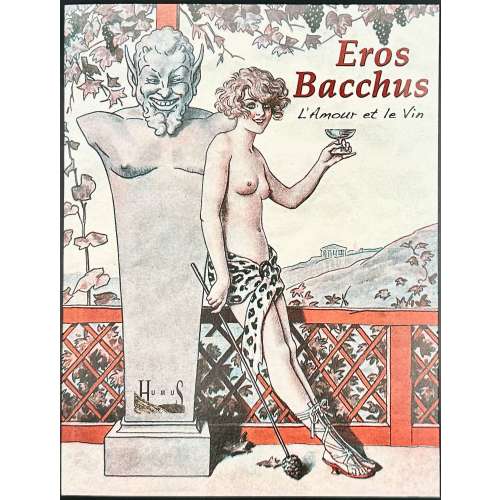 NEWBound in full-colour pictorial wrappers with French flaps, 250 x 190 x 35 mm, 1,311 g by weight, profusely illustrated volume, pp. [1-4] 5-427 [5], 216 leaves total. Title-page: {vignette} | EROS BACCHUS | L'amour et le vin | {publisher's device} || Exhibition at Château Musée du vin et de la vigne, à Aigle, du 24 mai 2014 au 28 février 2015. Text by Michel Froidevaux. Original description : Depuis l'apparition du vignoble, l'amour et le vin sont inséparables. Tantôt boisson des dieux, tantôt breuvage des poètes, le vin a la vertu de rapprocher les êtres. De la riche mythologie antique - Dionysos et Bacchus - aux fêtes des confréries contemporaines, le vin enflamme l'imaginaire et génère de la convivialité. L'idée est de proposer un parcours ludique et culturel, badin et savant pour aller par siècles et contrées à la découverte des plaisirs du boire et des méandres du désir. Livre richement illustré d'un millier d'images (dessins, objets, cartes postales,...) avec la participation d'une quarantaine d'artistes contemporains qui ont créé spécialement une œuvre. Machine translation: Love and wine have been inseparable since the dawn of the vineyard. Sometimes the drink of the gods, sometimes the beverage of poets, wine has the virtue of bringing people together. From the rich mythology of antiquity - Dionysus and Bacchus - to contemporary brotherhood celebrations, wine fires the imagination and generates conviviality. The idea is to offer a playful and cultural journey, both playful and learned, through centuries and lands, to discover the pleasures of drinking and the twists and turns of desire. The book is richly illustrated with some 1,000 images (drawings, objects, postcards, etc.), featuring works by some 40 contemporary artists.
NEWBound in full-colour pictorial wrappers with French flaps, 250 x 190 x 35 mm, 1,311 g by weight, profusely illustrated volume, pp. [1-4] 5-427 [5], 216 leaves total. Title-page: {vignette} | EROS BACCHUS | L'amour et le vin | {publisher's device} || Exhibition at Château Musée du vin et de la vigne, à Aigle, du 24 mai 2014 au 28 février 2015. Text by Michel Froidevaux. Original description : Depuis l'apparition du vignoble, l'amour et le vin sont inséparables. Tantôt boisson des dieux, tantôt breuvage des poètes, le vin a la vertu de rapprocher les êtres. De la riche mythologie antique - Dionysos et Bacchus - aux fêtes des confréries contemporaines, le vin enflamme l'imaginaire et génère de la convivialité. L'idée est de proposer un parcours ludique et culturel, badin et savant pour aller par siècles et contrées à la découverte des plaisirs du boire et des méandres du désir. Livre richement illustré d'un millier d'images (dessins, objets, cartes postales,...) avec la participation d'une quarantaine d'artistes contemporains qui ont créé spécialement une œuvre. Machine translation: Love and wine have been inseparable since the dawn of the vineyard. Sometimes the drink of the gods, sometimes the beverage of poets, wine has the virtue of bringing people together. From the rich mythology of antiquity - Dionysus and Bacchus - to contemporary brotherhood celebrations, wine fires the imagination and generates conviviality. The idea is to offer a playful and cultural journey, both playful and learned, through centuries and lands, to discover the pleasures of drinking and the twists and turns of desire. The book is richly illustrated with some 1,000 images (drawings, objects, postcards, etc.), featuring works by some 40 contemporary artists. -
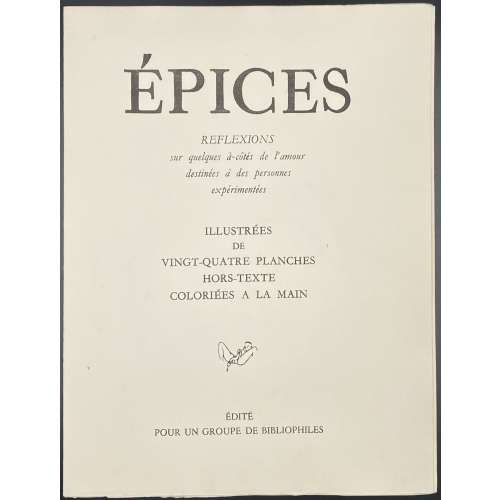 Description: French flapped wrappers, 27 x 20.5 cm, 134 gatherings, plus two leaves (blank, h.t. / limitation) at the beginning (54 leaves total), the first and the last two leaves blank, two pages in each of 12 gatherings (24 total) are hand-painted photogravures after etchings by an anonymous artist, attributed to Santippa, pseudonym of Georges or Gaston Hoffmann, or, possibly, of André Collot; the gatherings are unbound, pp. [1-10] 11-99 [100] [8] (108 pages total). Title-page: ÉPICES | REFLEXIONS | sur quelques à-côtés de l'amour | destinées à des personnes | expérimentées | ILLUSTREES | DE | VINGT-QUATRE PLANCHES | HORS-TEXTE | COLORIÉES A LA MAIN | {vignette} | ÉDITÉ | POUR UN GROUPE DE BIBLIOPHILES || Edition: limited to 500 copies numbered from 1 to 480 + 20 hand-numbered with Roman numbers. This is copy № 273. Enrichment: one original sketch (for Coucou… ou l’erreur de porte), one etching before letters and the same after letters and coloured (Le petit coin tranquille.. 19/20), and a full suite of 24 original etchings in sepia on cream paper, 20 of them on Arches and 4 on BFK Rives) printed for the first 17 copies of the 1950 edition (55 copies were printed then). In addition: one graphite pencil sketch which is not part of the suite. Catalogue raisonné: Dutel 1920 – 1970: № 1490 (for 1950), № 1491 (for 1955).
Description: French flapped wrappers, 27 x 20.5 cm, 134 gatherings, plus two leaves (blank, h.t. / limitation) at the beginning (54 leaves total), the first and the last two leaves blank, two pages in each of 12 gatherings (24 total) are hand-painted photogravures after etchings by an anonymous artist, attributed to Santippa, pseudonym of Georges or Gaston Hoffmann, or, possibly, of André Collot; the gatherings are unbound, pp. [1-10] 11-99 [100] [8] (108 pages total). Title-page: ÉPICES | REFLEXIONS | sur quelques à-côtés de l'amour | destinées à des personnes | expérimentées | ILLUSTREES | DE | VINGT-QUATRE PLANCHES | HORS-TEXTE | COLORIÉES A LA MAIN | {vignette} | ÉDITÉ | POUR UN GROUPE DE BIBLIOPHILES || Edition: limited to 500 copies numbered from 1 to 480 + 20 hand-numbered with Roman numbers. This is copy № 273. Enrichment: one original sketch (for Coucou… ou l’erreur de porte), one etching before letters and the same after letters and coloured (Le petit coin tranquille.. 19/20), and a full suite of 24 original etchings in sepia on cream paper, 20 of them on Arches and 4 on BFK Rives) printed for the first 17 copies of the 1950 edition (55 copies were printed then). In addition: one graphite pencil sketch which is not part of the suite. Catalogue raisonné: Dutel 1920 – 1970: № 1490 (for 1950), № 1491 (for 1955).

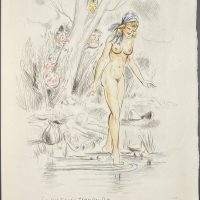
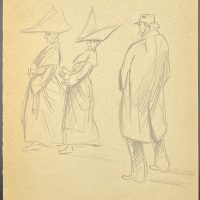
-
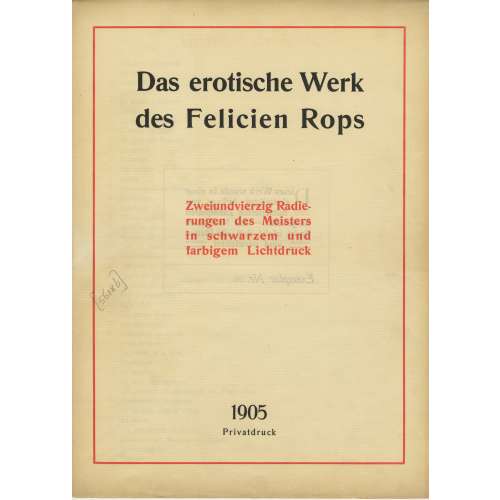
A limited-edition (№26/500) set of 42 etchings and drypoints after Félicien Rops (Belgian, 1833 – 1898), each mounted in a numbered passe-partout, printed posthumously by an anonym in Germany in 1905; in a flapped half faux suede-backed cardboard portfolio with straps, 442 x 335 mm, red embossed lettering to the front cover, bookplate of Richard Teschner (Austrian, 1879 – 1948) pasted inside.
Title-page (in a red frame): Das erotische Werk | des Felicien Rops | Zweiundvierzig Radie- | rungen des Meisters | in schwarzem und | farbigem Lichtdruck | 1905 | Privatdruk ||
Limitation (in a red two-section frame) : Dieses Werk wurde in einer | einmaligen Auflage von | 500 numerierten Exemplaren | hergestellt. — Ein Nachdruck | findet nicht statt, die Platten | == sind vernichtet == | Exemplar Nr. 26 ||
Verzeichnis der Tafeln (Table of Contents): 1. Initiation sentimentale; 2. La croix; 3. Entre-acte; 4. Holocauste; 5. La bonne hollandaise; 6. Étude; 7. La femme au pantin; 8. L’amour de Satan; 9. Au pays des féminies; 10. La volupté; 11. Evocation; 12. De castitate; 13. Joujou; 14. Vengeance d’une femme; 15. Phantasies; 16. Indolence; 17. Théâtre gaillard; 18. Appel au peuple; 19. Masques modernes; 20. Tout est grand chez les rois; 21. Marie-Madeleine; 22. L’amante du Christ; 23. Feuille de vigne; 24. La messe de Guide; 25 Viol et prostitution; 26. Le maillot; 27. Les jeunes France; 28. Les diaboliques; 29. Coquetterie au miroir; 30. Jeune homme; 31. La femme et la mort; 32. Confidence; 33. La bergère; 34. La mère aux satyrions; 35. Les exercices de dévotion de Mr. Henri Roch; 36. Mademoiselle de Maupin; 37. Le bonheur dans le crime; 38. La sirène; 39. Les cabotinages de l’amour; 40. Document sur l’impuissance d’aimer; 41. A cœur perdu; 42. Curieuse.
-
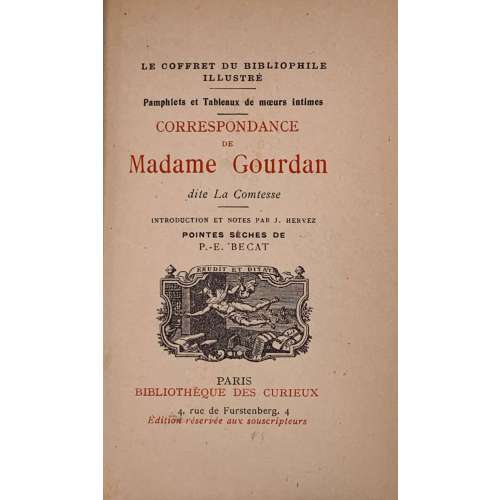 Front wrapper and title-page (in red and black): LE COFFRET DU BIBLIOPHILE ILLUSTRE | Pamphlets et Tableaux de mœurs intimes | CORRESPONDANCE | DE | Madame Gourdan | dite La Comtesse | INTRODUCTION ET NOTES PAR J. HERVEZ. | POINTES SÈCHES DE | P.-E. BECAT | {device} | PARIS | BIBLIOTHÈQUE DES CURIEUX | 4, rue de Furstenberg, 4 | Édition réservée aux souscripteurs || Limitation: L'édition illustrée du "Coffret | du bibliophile" est tirée à 750 | exemplaires, sur vergé de Rives, | – numérotés de 1 à 750 – | № 353 || Limited edition of 750 copies on Rives laid paper, of which this is copy № 353. Collation: fep, 3 blanks, front wrapper, 3 blanks vergé, [2] h.t. / limit., [2] t.p., [5] 6-188, blank, back wrapper, 3 blanks, fep., plus 12 plates, dry-points by P.-É. Bécat, extraneous to collation, incl. frontispiece. Binding: 16 x 10.3 cm, red crushed morocco, gilt lettering to spine, marbled endpapers, printed on laid paper, original wrappers preserved. Contributors: Marguerite Gourdan [Marguerite Alexandrine Ernestine Stock] (French, c. 1730 –1783) – fictional author. Jean Hervez (French, 1864 – ?) – author (preface). Charles Théveneau de Morande (French, 1741 – 1805) – presumable author of the text. Paul-Émile Bécat (French, 1885 – 1960) – artist. Bibliothèque des curieux [Georges & Robert Briffaut], Georges Briffaut (French, 1886 – 1973) – publisher. Previous editions: First published 1783, under the title: "Le portefeuille de Madame Gourdan" in London by Jean Nourse. Bibliothèque des curieux, 1910. Bibliothèque des curieux, 1924.
Front wrapper and title-page (in red and black): LE COFFRET DU BIBLIOPHILE ILLUSTRE | Pamphlets et Tableaux de mœurs intimes | CORRESPONDANCE | DE | Madame Gourdan | dite La Comtesse | INTRODUCTION ET NOTES PAR J. HERVEZ. | POINTES SÈCHES DE | P.-E. BECAT | {device} | PARIS | BIBLIOTHÈQUE DES CURIEUX | 4, rue de Furstenberg, 4 | Édition réservée aux souscripteurs || Limitation: L'édition illustrée du "Coffret | du bibliophile" est tirée à 750 | exemplaires, sur vergé de Rives, | – numérotés de 1 à 750 – | № 353 || Limited edition of 750 copies on Rives laid paper, of which this is copy № 353. Collation: fep, 3 blanks, front wrapper, 3 blanks vergé, [2] h.t. / limit., [2] t.p., [5] 6-188, blank, back wrapper, 3 blanks, fep., plus 12 plates, dry-points by P.-É. Bécat, extraneous to collation, incl. frontispiece. Binding: 16 x 10.3 cm, red crushed morocco, gilt lettering to spine, marbled endpapers, printed on laid paper, original wrappers preserved. Contributors: Marguerite Gourdan [Marguerite Alexandrine Ernestine Stock] (French, c. 1730 –1783) – fictional author. Jean Hervez (French, 1864 – ?) – author (preface). Charles Théveneau de Morande (French, 1741 – 1805) – presumable author of the text. Paul-Émile Bécat (French, 1885 – 1960) – artist. Bibliothèque des curieux [Georges & Robert Briffaut], Georges Briffaut (French, 1886 – 1973) – publisher. Previous editions: First published 1783, under the title: "Le portefeuille de Madame Gourdan" in London by Jean Nourse. Bibliothèque des curieux, 1910. Bibliothèque des curieux, 1924. -
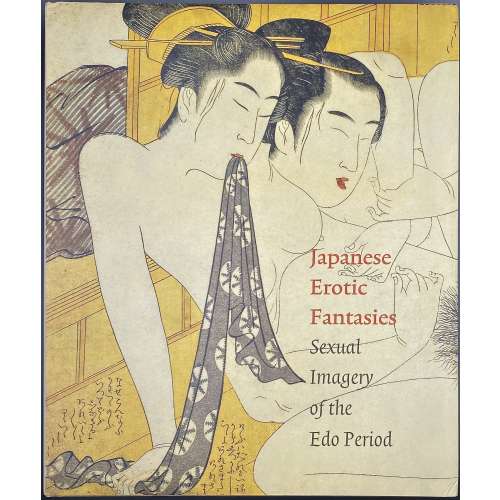 Hardcover volume, 30 x 25.5 cm, in brown cloth with yellow lettering to front cover and spine, in pictorial dust jacket, profusely illustrated in colour; pp.: [1-5] 6-256, total 128 leaves. Title-page (red and black): Japanese | Erotic | Fantasies | Sexual | Imagery | of the | Edo Period | Chris Uhlenbeck and | Margarita Winkel | with contributions by | Ellis Tinios | Cecilia Segawa Seigle | Oikawa Shigeru | Editor Amy Reigle Newland | {publisher’s device} Hotei Publishing, Amsterdam || Contents: Preface by Chris Uhlenbeck; Acknowledgements by Chris Uhlenbeck & Margarita Winkel; Editorial Notes; Shunga: the Issues by Chris Uhlenbeck; The Setting for shunga: the Yoshiwara by Cecilia Segawa Seigle; Erotic Books in the Floating World of Urban Life by Margarita Winkel; The Catalogue ('The Primitives'; The Age of Harunobu, Kiyonaga and Utamaro; The Nineteenth Century; The Meiji Period and Beyond); Appendix: Japanese characters for book, print and series titles; Glossary; Bibliography; General Index; Artists' Index. This publication coincides with the Exhibition "Desire of Spring. Erotic Fantasies in Edo Japan" from 22 January to 17 April 2005 in the Kunsthal Rotterdam (Impressum). Literaturverzeichnis: Seiten 247-250. Contributors: Chris Uhlenbeck Margarita Winkel Ellis Tinios Cecilia Segawa Seigle Oikawa Shigeru Amy Reigle Newland In this collection:
Hardcover volume, 30 x 25.5 cm, in brown cloth with yellow lettering to front cover and spine, in pictorial dust jacket, profusely illustrated in colour; pp.: [1-5] 6-256, total 128 leaves. Title-page (red and black): Japanese | Erotic | Fantasies | Sexual | Imagery | of the | Edo Period | Chris Uhlenbeck and | Margarita Winkel | with contributions by | Ellis Tinios | Cecilia Segawa Seigle | Oikawa Shigeru | Editor Amy Reigle Newland | {publisher’s device} Hotei Publishing, Amsterdam || Contents: Preface by Chris Uhlenbeck; Acknowledgements by Chris Uhlenbeck & Margarita Winkel; Editorial Notes; Shunga: the Issues by Chris Uhlenbeck; The Setting for shunga: the Yoshiwara by Cecilia Segawa Seigle; Erotic Books in the Floating World of Urban Life by Margarita Winkel; The Catalogue ('The Primitives'; The Age of Harunobu, Kiyonaga and Utamaro; The Nineteenth Century; The Meiji Period and Beyond); Appendix: Japanese characters for book, print and series titles; Glossary; Bibliography; General Index; Artists' Index. This publication coincides with the Exhibition "Desire of Spring. Erotic Fantasies in Edo Japan" from 22 January to 17 April 2005 in the Kunsthal Rotterdam (Impressum). Literaturverzeichnis: Seiten 247-250. Contributors: Chris Uhlenbeck Margarita Winkel Ellis Tinios Cecilia Segawa Seigle Oikawa Shigeru Amy Reigle Newland In this collection: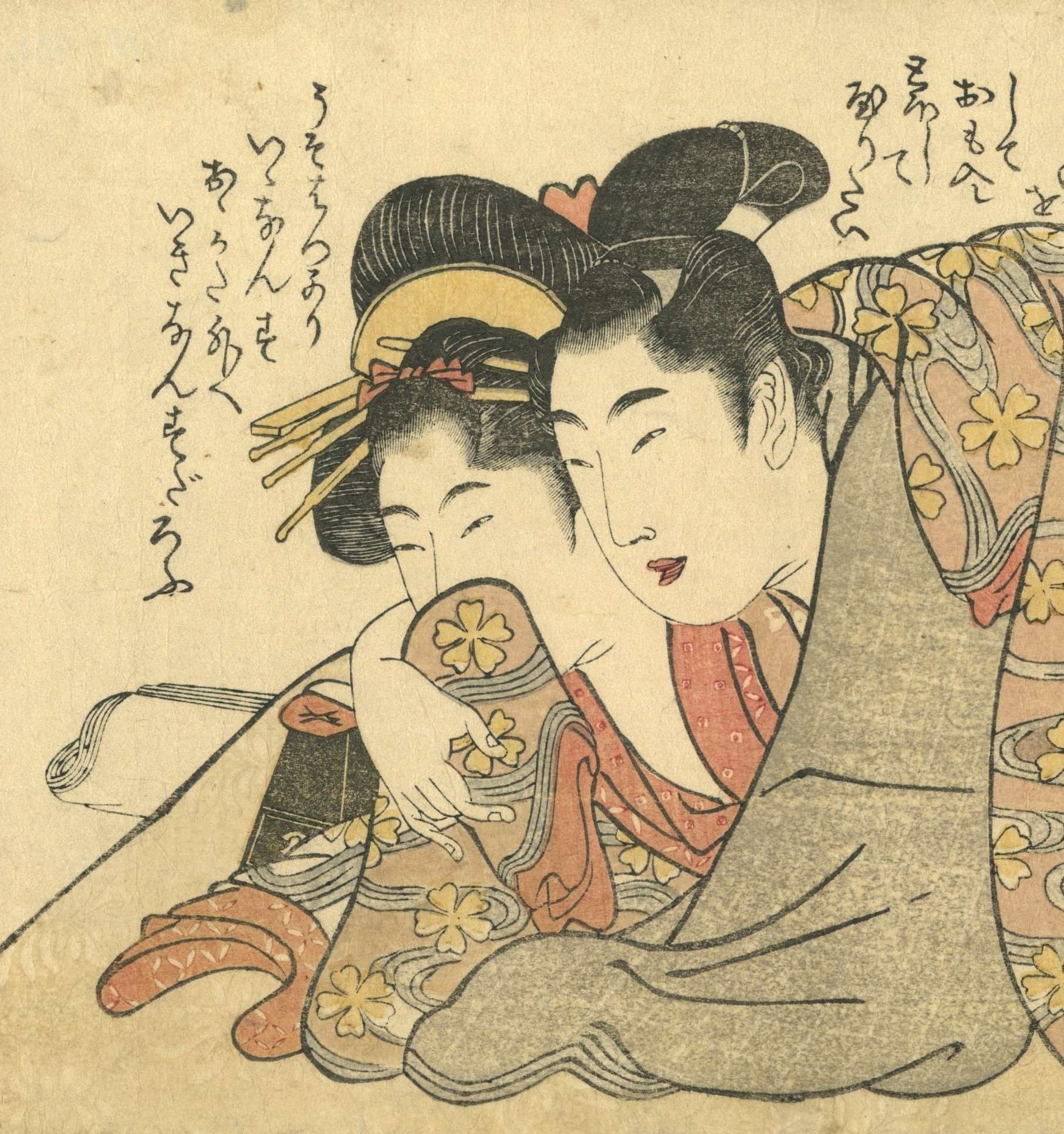
SVJP-0188.2015: Kitagawa Utamaro. Series of horizontal o-hosoban shunga prints, c. 1803.
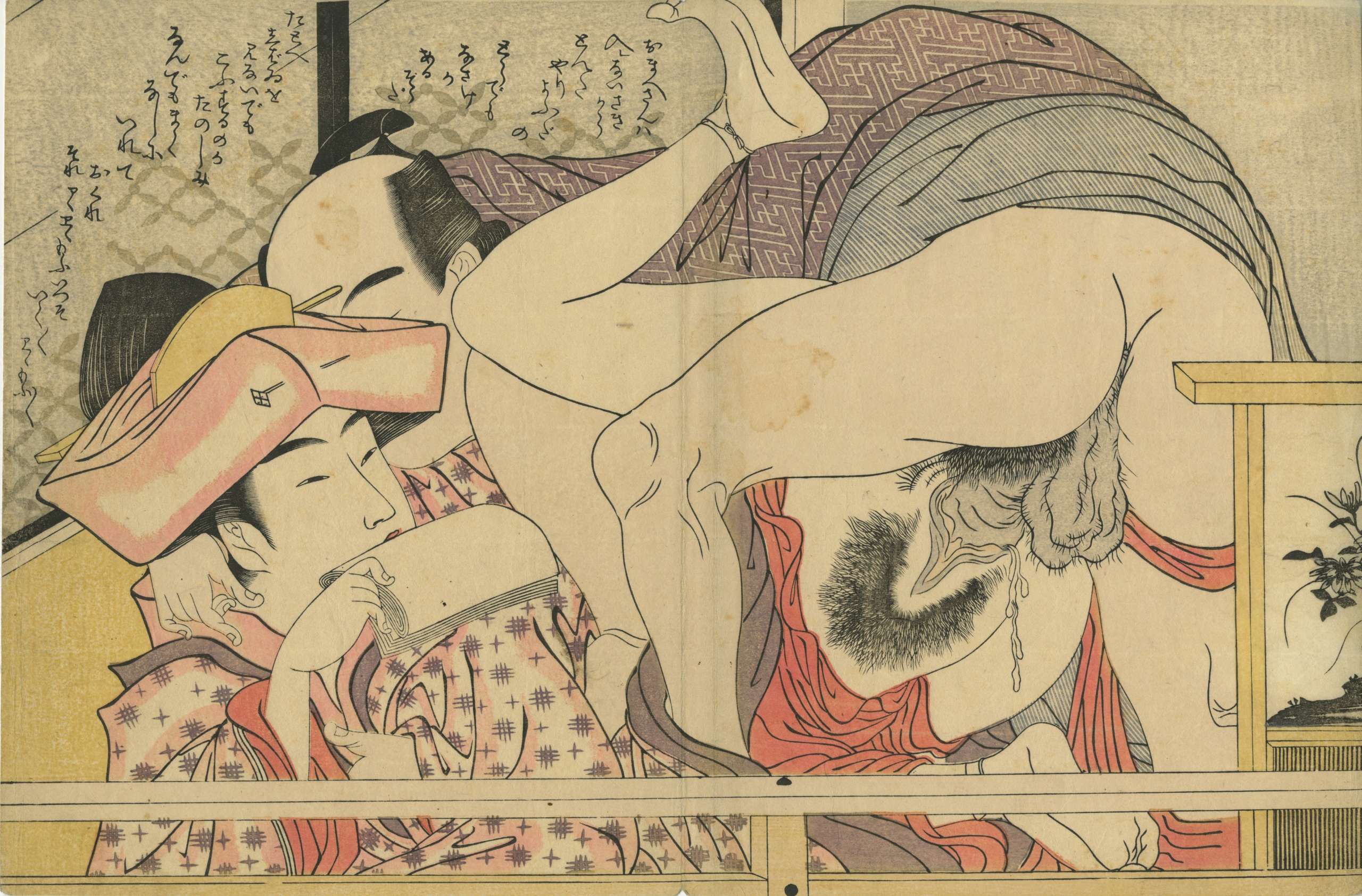
SVJP-0034.2014: Chōkyōsai Eiri. Neat version of a love letter (Fumi no kiyogaki), 1801.

SVJP-0041.2013: Torii Kiyonaga. Handscroll for the sleeve (Sode no maki), c. 1785.
-
 Woodblock print album of thirteen prints, ōban, nishiki-e. Artist: Chōkyōsai Eiri [鳥橋斎 栄里] (Japanese, fl. c. 1789 ~ 1801 ). Models of calligraphy (Fumi no kiyogaki), New Year 1801. This title is taken from Chris Uhlenbeck's Japanese Erotic Fantasies Sexual Imagery of the Edo Period. — Hotei Publishing, 2005, ISBN 90-74822-66-5):. A detailed description of the album can be found at The Complete Ukiyo-e Shunga №9 Eiri, 1996, ISBN 4-309-91019. Most of the edition is in Japanese, though Richard Lane writes a section in English: Eiri: Love-letters, Love Consummated: Fumi-no-kiyogaki. The article starts with the following statement: "Why all the fuss about Sharaku? Because he is so "mysterious"? No, not at all: because he is such a good artist. But Sharaku is not the only great yet enigmatic ukiyo-e artist and I propose to resurrect here one of his important contemporaries who has been all too long neglected: Chōkyōsai Eiri. As with many of the notable ukiyo-e masters, nothing is known of Eiri's biography. All we can say is what we learn from his extant prints and paintings: that he flourished during the second half of the Kansei Period [1789-1801]; and that he was a direct pupil of the great Eishi - who, being of eminent samurai stock, may well have attracted pupils of similar background." Another citation from Japanese Erotic Fantasies: "This album is one of the boldest sets of ōban-size shunga known, The first edition contains thirteen instead of the customary twelve designs". Here I present all thirteen prints, though the edition I bought in Kyoto in 2014 contained only twelve. The thirteenth print was purchased later in the United States (sheet №12).
Woodblock print album of thirteen prints, ōban, nishiki-e. Artist: Chōkyōsai Eiri [鳥橋斎 栄里] (Japanese, fl. c. 1789 ~ 1801 ). Models of calligraphy (Fumi no kiyogaki), New Year 1801. This title is taken from Chris Uhlenbeck's Japanese Erotic Fantasies Sexual Imagery of the Edo Period. — Hotei Publishing, 2005, ISBN 90-74822-66-5):. A detailed description of the album can be found at The Complete Ukiyo-e Shunga №9 Eiri, 1996, ISBN 4-309-91019. Most of the edition is in Japanese, though Richard Lane writes a section in English: Eiri: Love-letters, Love Consummated: Fumi-no-kiyogaki. The article starts with the following statement: "Why all the fuss about Sharaku? Because he is so "mysterious"? No, not at all: because he is such a good artist. But Sharaku is not the only great yet enigmatic ukiyo-e artist and I propose to resurrect here one of his important contemporaries who has been all too long neglected: Chōkyōsai Eiri. As with many of the notable ukiyo-e masters, nothing is known of Eiri's biography. All we can say is what we learn from his extant prints and paintings: that he flourished during the second half of the Kansei Period [1789-1801]; and that he was a direct pupil of the great Eishi - who, being of eminent samurai stock, may well have attracted pupils of similar background." Another citation from Japanese Erotic Fantasies: "This album is one of the boldest sets of ōban-size shunga known, The first edition contains thirteen instead of the customary twelve designs". Here I present all thirteen prints, though the edition I bought in Kyoto in 2014 contained only twelve. The thirteenth print was purchased later in the United States (sheet №12). №1: "...one of the most exotic scenes in all shunga. A Dutch kapitan is discovered coupling with a lovely Japanese courtesan, beside a large window opening upon a garden...".
№1: "...one of the most exotic scenes in all shunga. A Dutch kapitan is discovered coupling with a lovely Japanese courtesan, beside a large window opening upon a garden...".

 №2: "...a fair young harlot is seen masturbating with a grinding-pestle - a man watches intently from under bedding." [I have two specimens of this design; the one from album is more soiled but less faded].
№2: "...a fair young harlot is seen masturbating with a grinding-pestle - a man watches intently from under bedding." [I have two specimens of this design; the one from album is more soiled but less faded].
 №3: "...the artist has effectively contrasted the lovers by depicting the man's face as seen through the geisha's gauze skirt. [...] we are impressed more by strikingly elegant composition, the dramatic coloring, rather than feeling any great urge to participate in the energetic proceedings..."
№3: "...the artist has effectively contrasted the lovers by depicting the man's face as seen through the geisha's gauze skirt. [...] we are impressed more by strikingly elegant composition, the dramatic coloring, rather than feeling any great urge to participate in the energetic proceedings..."
 №4: "This scene is a most straightforward one, featuring the standard Missionary Position [capitalization by R. Lane].; but withal, the contrast of the young and naked, secret lover and the richly-clothed courtesan amid luxurious bedding..."
№4: "This scene is a most straightforward one, featuring the standard Missionary Position [capitalization by R. Lane].; but withal, the contrast of the young and naked, secret lover and the richly-clothed courtesan amid luxurious bedding..."
 №5: "In a striking lesbian scene (which has no equivalent in Utamaro, and is, incidentally, often omitted in later editions of this album), the girl at left prepares to receive the harikata (dildo) worn by the older girl at right (who holds a seashell containing lubricant)."
№5: "In a striking lesbian scene (which has no equivalent in Utamaro, and is, incidentally, often omitted in later editions of this album), the girl at left prepares to receive the harikata (dildo) worn by the older girl at right (who holds a seashell containing lubricant)."
 №6: "In the first appearance of a matronly heroine in this series, we find a widow - with shaven eyebrows and clipped hair - sporting with a handsome yound shop-clerk, mounting him with all her might."
№6: "In the first appearance of a matronly heroine in this series, we find a widow - with shaven eyebrows and clipped hair - sporting with a handsome yound shop-clerk, mounting him with all her might."

 №7: "... lady of samurai court: here, shown taking advantage of an official outing to temple and theatre, to rendezvous with a secret lover on a teahouse balcony." R. Lane considers this design the least successful in the series, especially in comparison with the same theme by Utamaro: "Utamaro female is almost ferocious in her lust for sexual gratification", which does not sound true to me. See Utamaro's sheet №5 from the album Utamakura (歌まくら, Poem of the Pillow) [courtesy The British Museum without permission]:
№7: "... lady of samurai court: here, shown taking advantage of an official outing to temple and theatre, to rendezvous with a secret lover on a teahouse balcony." R. Lane considers this design the least successful in the series, especially in comparison with the same theme by Utamaro: "Utamaro female is almost ferocious in her lust for sexual gratification", which does not sound true to me. See Utamaro's sheet №5 from the album Utamakura (歌まくら, Poem of the Pillow) [courtesy The British Museum without permission]:
 Then, as Richard Lane states, "we are flung suddenly to the bottom rung of Edo society":
Then, as Richard Lane states, "we are flung suddenly to the bottom rung of Edo society":
 №8: "Here we find a fair yotaka ('night-hawk', e.i. streetwalker) accommodating a lusty client in a lumberyard by the bank of the Sumida River".
№8: "Here we find a fair yotaka ('night-hawk', e.i. streetwalker) accommodating a lusty client in a lumberyard by the bank of the Sumida River".
 №9: '... a slightly plump harlot of the lower class receives a night visit from her lover, whose naked form she tries to cover with a cloak."
№9: '... a slightly plump harlot of the lower class receives a night visit from her lover, whose naked form she tries to cover with a cloak."
 №10: "...likely maidservant and lackey - are depicted in bath-room, their passions are all too obviously fired by steaming water."
№10: "...likely maidservant and lackey - are depicted in bath-room, their passions are all too obviously fired by steaming water."
 №11: "...this scene of courtesan and secret lover ranks high not only in Eiri's œuvre but also in the annals of the ukiyo-e genre itself. Both design and colouring are impeccable and, for this period, there is nothing even in the work of great Utamaro that really surpasses it." Again, a doubtful statement, however, this is Utamaro's design for the reader to judge:
№11: "...this scene of courtesan and secret lover ranks high not only in Eiri's œuvre but also in the annals of the ukiyo-e genre itself. Both design and colouring are impeccable and, for this period, there is nothing even in the work of great Utamaro that really surpasses it." Again, a doubtful statement, however, this is Utamaro's design for the reader to judge:
 The last design in my album is this:
The last design in my album is this:
 #13: In most reference books it goes under number 13, and we will assign this number to the sheet. "The final scene of the album features naked participants, probably samurai man and wife. The print is rather subdued in tone and colour, if not in the degree of the passion displayed..."
An additional sheet, acquired separately from a reputable dealer in New York, is usually listed as №12:
#13: In most reference books it goes under number 13, and we will assign this number to the sheet. "The final scene of the album features naked participants, probably samurai man and wife. The print is rather subdued in tone and colour, if not in the degree of the passion displayed..."
An additional sheet, acquired separately from a reputable dealer in New York, is usually listed as №12:
 №12: "One might think that Eiri has reached his peak with the preceding plate 11 - and indeed he has, in both esthetic and erotic terms. But the album is not yet finished, and the next scene lends a needed variety to the series, a slightly comic tableau featuring a middle-aged lackey attempting to forcibly seduce a servant girl of the same domicile". Utamaro's design, that inspired Eiri is here:
№12: "One might think that Eiri has reached his peak with the preceding plate 11 - and indeed he has, in both esthetic and erotic terms. But the album is not yet finished, and the next scene lends a needed variety to the series, a slightly comic tableau featuring a middle-aged lackey attempting to forcibly seduce a servant girl of the same domicile". Utamaro's design, that inspired Eiri is here:
 All descriptions are taken from Richard Lane's article at The Complete Ukiyo-e Shunga №9 Eiri, 1996. He concluded: "...Eiri's erotic series represents a major contribution to shunga art towards the close of ukiyo-e "Golden Age". In part inspired by Utamaro's classic album, this series withal constitutes a unified and original achievement, providing a cumulative effect of gracefully elegant yet glowing eroticism, which remains in the mind's eye long after the pictures themselves are far away."
I only would like to mention here that in several reference sources this album goes under name of Eisho; unfortunately, this mistake is reproduced at www.ukiyo-e.org, which miraculously shows exactly my print, but under the wrong name of the artist. The same mistake can be found at Shunga. The art of love in Japan. Tom and Mary Anne Evans. Paddington Press Ltd., 1975. ISBN 0-8467-0066-2; plates 6.74-6.77: Chōkyōsai Eishō, c. 1800. Even the British Museum edition of 2010 gives the same erroneous attribution: Chōkyōsai Eishō (1793-1801); they provide the following translation of title: "Clean Draft of a Letter" [see: Shunga. Erotic art in Japan. Rosina Buckland. The British Museum Press, 2010; pp. 110-112]. To the honour of the British Museum, I must admit that they have corrected themselves in Shunga. Sex and pleasure in Japanese art. Edited by Timothy Clark, et al. Hotei Publishing, 2013. Now, they say Chōkyōsai Eiri (worked c. 1790s-1801); they also provide a new title: "Neat Version of the Love Letter, or Pure Drawings of Female Beauty". I have already mentioned Richard Lane's version of title: "Love-letters, Love Consummated", and Chris Uhlenbeck's "Models of calligraphy". In poorly designed and printed Shunga. Erotic figures in Japanese art. Presented by Gabriele Mandel. Translated by Alison L'Eplattenier. Crescent Books, New York, 1983, the artist is named Shokyosai Eisho (beginning of the 19th century); title provided: "Models of Calligraphy". Correct attribution to Chōkyōsai Eiri also can be found at Poem of the pillow and other stories by Utamaro, Hokusai, Kuniyoshi and other artists of the floating world. Gian Carlo Calza in collaboration with Stefania Piotti. Phaidon Press, 2010; though the title is translated as "Clean Copy of Female Beauty".
All descriptions are taken from Richard Lane's article at The Complete Ukiyo-e Shunga №9 Eiri, 1996. He concluded: "...Eiri's erotic series represents a major contribution to shunga art towards the close of ukiyo-e "Golden Age". In part inspired by Utamaro's classic album, this series withal constitutes a unified and original achievement, providing a cumulative effect of gracefully elegant yet glowing eroticism, which remains in the mind's eye long after the pictures themselves are far away."
I only would like to mention here that in several reference sources this album goes under name of Eisho; unfortunately, this mistake is reproduced at www.ukiyo-e.org, which miraculously shows exactly my print, but under the wrong name of the artist. The same mistake can be found at Shunga. The art of love in Japan. Tom and Mary Anne Evans. Paddington Press Ltd., 1975. ISBN 0-8467-0066-2; plates 6.74-6.77: Chōkyōsai Eishō, c. 1800. Even the British Museum edition of 2010 gives the same erroneous attribution: Chōkyōsai Eishō (1793-1801); they provide the following translation of title: "Clean Draft of a Letter" [see: Shunga. Erotic art in Japan. Rosina Buckland. The British Museum Press, 2010; pp. 110-112]. To the honour of the British Museum, I must admit that they have corrected themselves in Shunga. Sex and pleasure in Japanese art. Edited by Timothy Clark, et al. Hotei Publishing, 2013. Now, they say Chōkyōsai Eiri (worked c. 1790s-1801); they also provide a new title: "Neat Version of the Love Letter, or Pure Drawings of Female Beauty". I have already mentioned Richard Lane's version of title: "Love-letters, Love Consummated", and Chris Uhlenbeck's "Models of calligraphy". In poorly designed and printed Shunga. Erotic figures in Japanese art. Presented by Gabriele Mandel. Translated by Alison L'Eplattenier. Crescent Books, New York, 1983, the artist is named Shokyosai Eisho (beginning of the 19th century); title provided: "Models of Calligraphy". Correct attribution to Chōkyōsai Eiri also can be found at Poem of the pillow and other stories by Utamaro, Hokusai, Kuniyoshi and other artists of the floating world. Gian Carlo Calza in collaboration with Stefania Piotti. Phaidon Press, 2010; though the title is translated as "Clean Copy of Female Beauty".
-
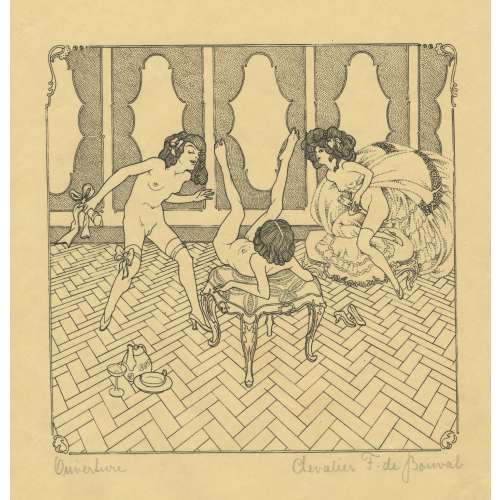 A set of sixteen planographic prints, signed and titled in pencil by owner “Chevalier F. de Bouval” (pseudonym of Franz von Bayros (Austrian, 1866 – 1924). Titles include: 1) Ouverture, 2) champagne brut, 3) maternité, 4) piano, 5) crudité délicieuse, 6. la belle vue, 7) au pensionnat, 8) le collier, 9) languelles pénètrelles, 10) introduction, 11) le sourrogat, 12) variation amoureuse, 13) la surprise, 14) le clef délicat, 15) le monstre gomme, 16) fruits de sud. Printed on wove paper, possibly engraved on wood after ink drawings by Franz von Bayros (Austrian, 1866 – 1924) under the pseudonym Chevalier F. de Bouval. Size: sheet 30 x 24 cm, image 18 x 17.5 cm. In another source, there are two more images from the same set: le passe-partout and la doublette, making 18 images altogether; the set is titled “Lesbia: XVIII sujets”, signed by Chevalier François René de Bouval.
A set of sixteen planographic prints, signed and titled in pencil by owner “Chevalier F. de Bouval” (pseudonym of Franz von Bayros (Austrian, 1866 – 1924). Titles include: 1) Ouverture, 2) champagne brut, 3) maternité, 4) piano, 5) crudité délicieuse, 6. la belle vue, 7) au pensionnat, 8) le collier, 9) languelles pénètrelles, 10) introduction, 11) le sourrogat, 12) variation amoureuse, 13) la surprise, 14) le clef délicat, 15) le monstre gomme, 16) fruits de sud. Printed on wove paper, possibly engraved on wood after ink drawings by Franz von Bayros (Austrian, 1866 – 1924) under the pseudonym Chevalier F. de Bouval. Size: sheet 30 x 24 cm, image 18 x 17.5 cm. In another source, there are two more images from the same set: le passe-partout and la doublette, making 18 images altogether; the set is titled “Lesbia: XVIII sujets”, signed by Chevalier François René de Bouval. -
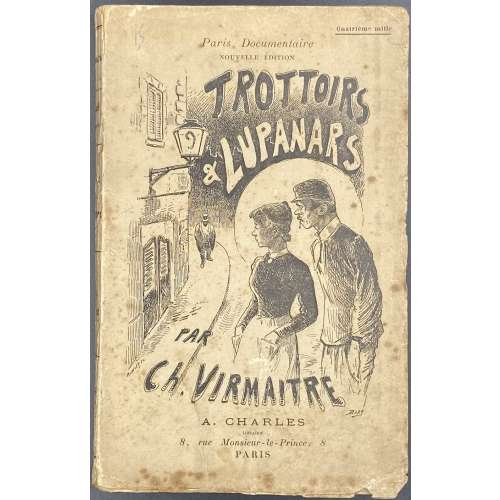 Front wrapper: Quatrième mille | Paris Documentaire | NOUVELLE ÉDITION | TROTTOIRS | ET | LUPANARS | PAR | Ch. VIRMAITRE | A. CHARLES | LIBRAIRE | 8, Rue Monsieur-le-Prince, 8 | PARIS || Title page: Ch. VIRMAITRE | PARIS DOCUMENTAIRE | (Mœurs) | TROTTOIRS | ET | LUPANARS | {fleuron} | A. CHARLES | LIBRAIRE | 8, Rue Monsieur-le-Prince, 8 | PARIS | 1897 || Collation: 18mo; Front pictorial wrapper, 2 ffls, π4, 118, 318, 518, 718, 918, 1118, 1318, 1514, back pictorial wrapper (portrait) Pagination: [1-7] 8-282 [6]. Binding: Publisher’s pictorial wrappers, lettering to spine. Charles Virmaître (French, 1835 – 1903).
Front wrapper: Quatrième mille | Paris Documentaire | NOUVELLE ÉDITION | TROTTOIRS | ET | LUPANARS | PAR | Ch. VIRMAITRE | A. CHARLES | LIBRAIRE | 8, Rue Monsieur-le-Prince, 8 | PARIS || Title page: Ch. VIRMAITRE | PARIS DOCUMENTAIRE | (Mœurs) | TROTTOIRS | ET | LUPANARS | {fleuron} | A. CHARLES | LIBRAIRE | 8, Rue Monsieur-le-Prince, 8 | PARIS | 1897 || Collation: 18mo; Front pictorial wrapper, 2 ffls, π4, 118, 318, 518, 718, 918, 1118, 1318, 1514, back pictorial wrapper (portrait) Pagination: [1-7] 8-282 [6]. Binding: Publisher’s pictorial wrappers, lettering to spine. Charles Virmaître (French, 1835 – 1903). -
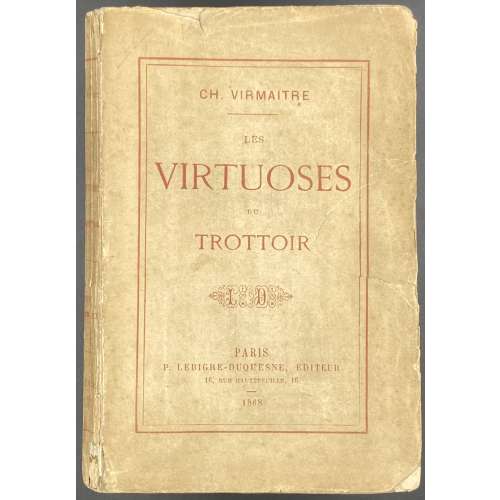 Cover: Ch. Virmaitre | LES | VIRTUOSES | DU | TROTTOIR | {publisher’s device} | PARIS | P. LEBIGRE-DUQUESNE, ÉDITEUR | 16, RUE HAUTEFEUILLE, 16 | 1868 || Title: Similar. Imprint: De Rouge Frères, Dunon et Fresné (Paris). Pagination: [1-7] 8-161 [162], [2] – table, [2] – advert., [14]; 90 leaves total; publisher’s cream wrappers with red lettering in double frame. Collation: 12mo in 6th; [1]-136, 1412. Charles Virmaître (French, 1835 – 1903).
Cover: Ch. Virmaitre | LES | VIRTUOSES | DU | TROTTOIR | {publisher’s device} | PARIS | P. LEBIGRE-DUQUESNE, ÉDITEUR | 16, RUE HAUTEFEUILLE, 16 | 1868 || Title: Similar. Imprint: De Rouge Frères, Dunon et Fresné (Paris). Pagination: [1-7] 8-161 [162], [2] – table, [2] – advert., [14]; 90 leaves total; publisher’s cream wrappers with red lettering in double frame. Collation: 12mo in 6th; [1]-136, 1412. Charles Virmaître (French, 1835 – 1903). -
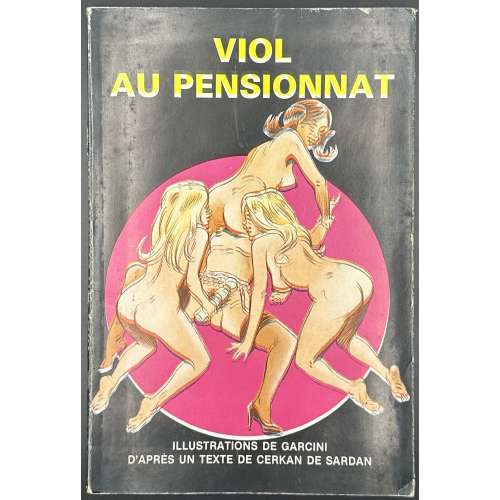 NEWSoftcover, French flapped pictorial wrappers, 240 x 160 mm, translated title: Rape at the boarding school, pp. [1-6] 7-164 [4], 40 black and white illustrations by Garcini. Title-page: D’après un texte de | CERKAN DE SARDAN | VIOL | AU PENSIONNAT | illustrations de | GARCINI ||
NEWSoftcover, French flapped pictorial wrappers, 240 x 160 mm, translated title: Rape at the boarding school, pp. [1-6] 7-164 [4], 40 black and white illustrations by Garcini. Title-page: D’après un texte de | CERKAN DE SARDAN | VIOL | AU PENSIONNAT | illustrations de | GARCINI || -
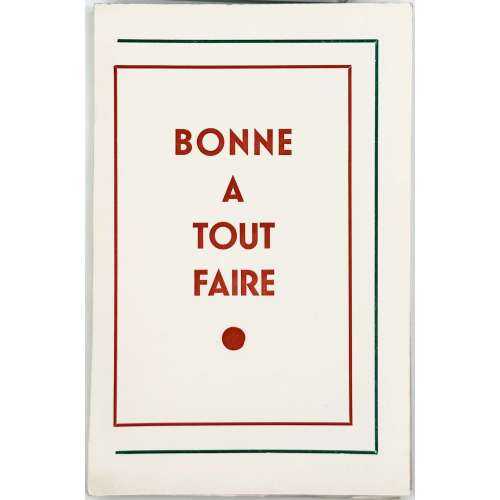 NEWA softcover volume 18.7 x 12.1 cm, in publisher’s cream wrappers, red lettering in red and green frames to front cover, in glassine dustwrapper, uncut, untrimmed, collated in 8vo: 1-98 104, pp. [1-8] 9-151 [152 blank], plus 6 illustrations reproduced in drypoint after Mario Tauzin's lithographs from the album 'Interdit aux adultes' (see SVE-0547.2024). Front cover : BONNE | A | TOUT | FAIRE Title-page : BONNE | A | TOUT | FAIRE Stated limited edition of 900, strictly for subscribers. According to J.-P. Dutel III 1108 (p.66): published by Éric Losfeld in the late 1950s. Bonne à tout faire is a French idiom = maid-of-all-work Éric Losfeld (Belgian-French, 1922 – 1979) — publisher Mario Tauzin (French, 1909 – 1979) — artist
NEWA softcover volume 18.7 x 12.1 cm, in publisher’s cream wrappers, red lettering in red and green frames to front cover, in glassine dustwrapper, uncut, untrimmed, collated in 8vo: 1-98 104, pp. [1-8] 9-151 [152 blank], plus 6 illustrations reproduced in drypoint after Mario Tauzin's lithographs from the album 'Interdit aux adultes' (see SVE-0547.2024). Front cover : BONNE | A | TOUT | FAIRE Title-page : BONNE | A | TOUT | FAIRE Stated limited edition of 900, strictly for subscribers. According to J.-P. Dutel III 1108 (p.66): published by Éric Losfeld in the late 1950s. Bonne à tout faire is a French idiom = maid-of-all-work Éric Losfeld (Belgian-French, 1922 – 1979) — publisher Mario Tauzin (French, 1909 – 1979) — artist


